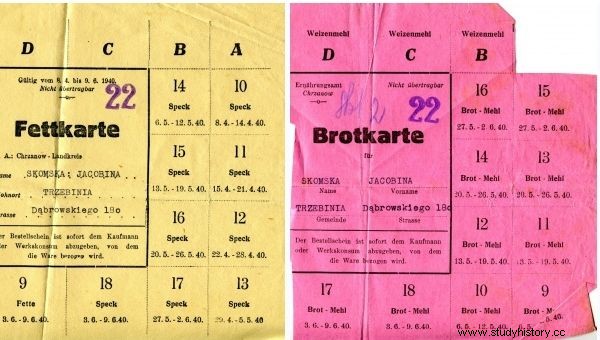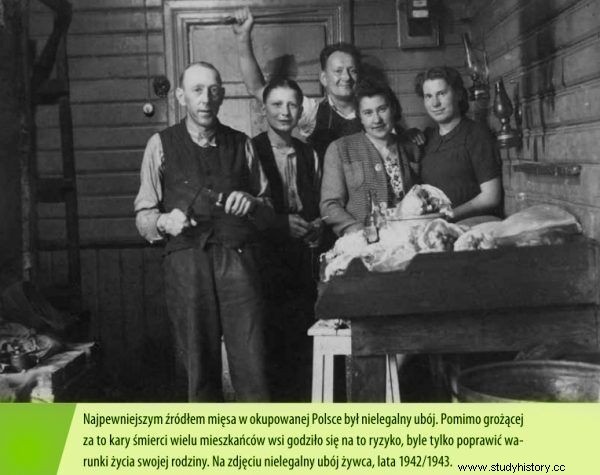Five years of brutal German oppression did not break the Polish fortitude. The brave women saved the Poles from hunger and desperation. Forgotten heroines of the occupation, fighting daily in kitchens, on black market markets and smuggling routes.
Hans Frank, a Nazi apparatchik appointed by Hitler to be the ruler of the General Government, had been making plans to raze 95 percent of Warsaw's buildings to the ground since 1940. This city, he said, was "the focus of confusion, the point from which anxiety spreads in this country." If the former Polish capital was to cease to exist anyway, in Frank's opinion nothing stood in the way of starving its inhabitants first.
In front of foreign correspondents, the Germans tried to be good-natured and humanitarian. From the first days of the occupation, they arranged field kitchens for Poles and a demonstration food distribution. They photographed almost every bowl of soup issued from all sides to send the right message to the world. Good Germans cares about these ragged Poles, but it was just a big bluff.
Starve the whole nation
The Nazis handed out the scraps. For example, in less than the first two months, the inhabitants of Warsaw received per person - 3 kilograms of bread, 25 grams of sugar, 200 grams of salt and 100 grams of rice. The caloric value of these allowances was approximately… 135 calories a day , which is less than one kaiser roll in it. Later the situation improved a bit, but still the cards satisfied only a fraction of the daily needs of a healthy organism. It was not a card system, but rather a starvation system.

German sheets of grease (left) and bread.
To survive and ensure the survival of their loved ones, our grandmothers took matters into their own hands instead of relying on German grace. Immediately after the fighting stopped, illegal food trade began. Town dwellers from the countryside went to their relatives and friends to feed their family with their help. Initially, they only imported food for their own needs. Almost immediately, however, a black market began to emerge that fed the rest.
A bullet to the head for a slice of ham?
For illegal slaughter of animals, milling grain, or hiding crops, there were severe sanctions, including the death penalty. One could also die for the illegal transport of food. The order of the occupation authorities of July 15, 1941 made it clear: those guilty of smuggling and pasture would be sent to Treblinka. However, the constant threat did not deter wives and mothers fighting for their families' lives.
Smuggling food, they tried to cheat the German soldiers and Bahnschutz at every step. Most of the illegal transport traveled to Warsaw by trains. Thousands of women followed the words of the famous occupation song. “It's dark outside, the train is crowded, so the idyll begins. He embraced her in the half, she was as thick as an ox, because the chop was hidden under her coat ”- this is not only a rhyme, but also a reliable instruction of action. According to the estimates of the railwaymen themselves (Poles, of course!), one EKD train could fit even ... thirty dismembered bulls.
The pieces of meat were hidden in special hiding places prepared by the staff, on their own bodies, and sometimes also in… coffins. The latter method was used by the owner of one of the most popular pubs in the capital - "Wróbel". Already before the war, he cooperated with his relative who owned a butcher's shop in the Kielce region. With the spread of the Germans in Poland, the transport of meat did not stop.
It was just stuffed into coffins, not straight into the railroad car . The Germans were mortally afraid of typhus and other infectious diseases, so they were not in the habit of searching the corpses. On the other hand, they made sure that there were plenty of coffins in the trains.

(Illustration from the book by Aleksandra Zaprutko-Janicka "Occupation from the kitchen").
A city where you can buy everything
When food finally arrived in town, it immediately enriched the black market. On a European scale, Warsaw was its largest and most thriving center. Routes between the eastern and western fronts crossed in the Polish capital. Thanks to this, it was possible to buy goods from all over the world on the illegal market. If someone wanted to sell silverware or a smoked pig's leg, this is where he found a buyer. And most often the buyer, because both in smuggling and in clandestine trade, women were the leader.
Editors of the journal "Ekonomista Polski. The Polish Economist, published in Great Britain during the war years, they wrote without any exaggeration:
Currently there is a voucher in Warsaw that will have to be erected a monument to the "unknown merchant" after the war , sometimes working miracles of cunning and endurance to bring some food from the countryside to the city.
Luxury goods such as stockings and French perfumes flowed from the conquered countries of the West. The German soldiers themselves supplied Polish market stalls with illegal alcohol. However, food was sold on the largest scale. There was absolutely nothing in illegal circulation on the Vistula River. Thanks to the efforts of resourceful restaurateurs with contacts on the black market, in Warsaw's semi-legal pubs you could even try turtle soup. The latter was made, which is worth emphasizing, from real turtles, which, as a result of manipulation, ended up on the tables of Polish restaurants, and not in Wehrmacht factories.
Something out of nothing
Eating out in the city was a solution for the rich and less resourceful. Real Polish housewives knew that you can eat your fill even without visiting the diner and without paying attention to the restrictions imposed by the Germans.

(Illustration from the book by Aleksandra Zaprutko-Janicka "Occupation from the kitchen").
When there was no real flour, Polish women looked for a replacement elsewhere. The Germans controlled all the mills and confiscated the burrs, so the housewives often had to use an ordinary coffee grinder. With his help, they ground couch grass, acorns, birch bark and other gifts of nature .
The flour obtained in this way was used mainly for the multiplication of bread. A loaf baked with erzac-admixtures was still better than available for cards, hard as concrete, clay "bonowiec".
Plants that seem completely inedible to us may have landed on the plate. Among them were lebioda and nettle. Every now and then in modern kitchens there are trends encouraging to cook and eat weeds. Now it is a free choice of gourmets, during the occupation it was a sad necessity.

Polish housekeeper on the cover of one of the cookbooks published under the occupation.
Acorn coffee and carrot tea
Acorn flour was also used to make acorn coffee. It may not contain caffeine, but in the face of the widespread shortage of real coffee, it could at least replace its taste. Also real tea became a rarity during the war. Our grandmothers used their supplies very sparingly, for example by repeatedly brewing tea leaves. The coffee grounds trade also flourished on the black market. On a daily basis, Polish women drank their handmade substitutes. The tea could even be prepared with… dried carrot peelings.
If the hostess lacked her own ideas, she could always turn to reliable cookbooks for difficult times. During the occupation, various crisis guides appeared on the Polish book market.
There was a booklet with "100 Potato Dishes" and also a booklet explaining how to make "60 Cabbage Dishes".

Smuggling and secret trade. The basis of wartime existence for thousands of Polish women ...
Among the Polish military specialties there is a cake made of beans and laurel drops flavored with chestnut purée, as well as turnips stewed in caramel sauce.
You could also eat cabbage pudding, or meat chops made ... without meat. In one of the occupation cookbooks, there was even a recipe for a war version of French fries, called "potatoes in French".
The culinary arts that delighted the Allies
Rabbits prepared in various ways have become a popular delicacy. These animals were kept even in domestic bathrooms, pantries, balconies and corridors of tenement houses. The vegetables were brought from ... city parks. Many of them were turned into allotments during the war. The inhabitants of Warsaw were fed, for example, by an over twenty-hectare park named after Romuald Traugutt. Also near the Royal Castle, "among the silvery spruces", there is a place for a potato field.

(Illustration from the book by Aleksandra Zaprutko-Janicka "Occupation from the kitchen").
Even the British appreciated the resourcefulness of our housewives. In 1941, "Polish wartime cookery book" was published in Glasgow. On her cards, Zofia Nowosielska explained to her island friends how to stay healthy and full in the face of shortages in supplies. As a Pole, she knew exactly what she was talking about.
It's worth getting to know its history and the truth about the daily struggle that our grandmothers fought on the kitchen front. You can read about all this in the first and only book devoted to the culinary side of World War II. "Occupation from the kitchen. The Female Art of Survival " is the story of the great challenge faced by Polish women in 1939. But most of all - their extraordinary resourcefulness and forgotten success.
Source:
"Occupation from the kitchen" is the second book published by our portal. Thanks to it you will discover a completely unknown side of World War II.
